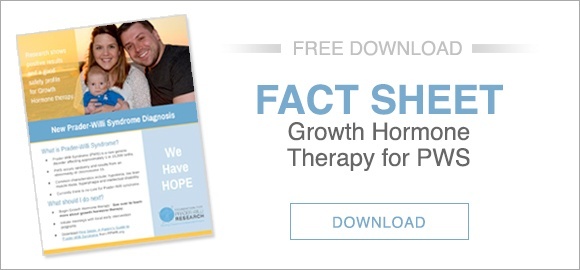The incidence of scoliosis in Prader-Willi syndrome is quite high (~30% in children under the age 10; up to ~80% in kids over the age of 10, compared to <3% in the general population). Because moderate to severe scoliosis can be associated with significant complications, and may require surgical intervention, it's important to understand and minimize contributing factors.
When growth hormone (GH) replacement therapy in PWS was first introduced, one concern was the possibility of increasing the incidence and/or severity of scoliosis, since scoliosis progression is most evident during periods of rapid growth. In fact, scoliosis is the most frequently reported adverse event in Pfizer's large database analysis of kids with PWS receiving GH (Craig, 2006). However, this does not necessarily mean that GH caused the scoliosis, and retrospective studies (where records are reviewed in hindsight) did not detect any difference in the rate or severity of scoliosis regardless of whether GH therapy was used or not (Nagai, 2006).
Nevertheless, some endocrinologists have still been reluctant to initially prescribe or continue GH therapy if a child with PWS develops scoliosis, potentially keeping the child from receiving the beneficial effects of GH on other parameters such as improved body composition, increased endurance, and better neurodevelopment. A study by a group in the Netherlands should put to bed any remaining concerns that GH replacement therapy may negatively impact the incidence or severity of scoliosis in PWS. The study Randomized Controlled Trial to Investigate the Effects of Growth Hormone Treatment on Scoliosis in Children with Prader-Willi Syndrome is prospective, meaning kids were randomly assigned to GH therapy or not, and the outcomes compared. Randomized controlled prospective studies are generally considered more robust than retrospective studies. Here, 91 infants and children with PWS, randomized to either receive GH or not, were followed for 1-2 years and the incidence and progression of scoliosis monitored. Kids receiving GH did not have an increased risk of scoliosis, nor did their existing scoliosis worsen compared to kids who did not receive GH (in some cases, GH therapy was associated with lessening of the curvature of the spine).
The things that were different between the groups, not surprisingly, were that the height and body composition of those receiving GH was significantly improved compared to those who did not get GH. Thus, the authors conclude that scoliosis should not be considered a contraindication for GH treatment in PWS; that is, kids with scoliosis should continue on with GH therapy so that they might receive the other benefits of GH, without fear that the GH will worsen the scoliosis compared to what it would otherwise be. For parents, this is an excellent paper to bring to the attention of their endocrinologist if onset or progression of scoliosis in their child causes the endo to consider slowing or stopping GH therapy.
A longer term study, reported at a Pediatric Endocrinology meeting in 2019, looked at the incidence and severity of scoliosis in children with PWS treated with GH or not, over an eight-year period. This study also showed no difference in the incidence of scoliosis. However, the severity of scoliosis was modestly better in children who received GH (less curvature), perhaps because of more/stronger muscles in those who received GH.
The only negative here is that the high incidence of scoliosis in kids with PWS remains poorly understood and ways to reduce the incidence and severity haven't come to light. Interestingly, in the first study, kids with low IGF-1 values at the start of the study (low IGF-1 is indicative of poor GH activity) were more likely to have scoliosis. This suggests that IGF-1, and by association, a better functioning GH system in general, may be protective against scoliosis, a scenario which would favor GH replacement therapy at an early age.
Additional work is needed to get at why scoliosis is such a problem in PWS, and what can be done to decrease incidence and severity, but this study strongly supports the continued use of GH, even in the presence of scoliosis, so that kids with PWS can continue to reap significant benefits of GH therapy.
Learn more about the importance of growth hormone therapy for PWS.








